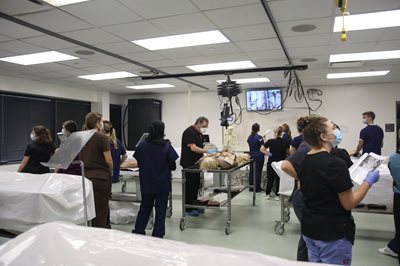We spoke with Michael Speirs, associate professor in the Physician Assistant Studies (PA) Program, about the on-campus cadaver lab and how it benefits the students at Salus.
Q: How did the lab get started and built?
The lab was constructed to meet the needs of the PA Program, which wanted to include cadaver dissection as part of the first-year experience. For the last 15 years, our PA students have had the opportunity to actually come in and perform hands-on dissection of human cadavers as part of their first-year education.
 Q: How is the cadaver lab utilized at Salus?
Q: How is the cadaver lab utilized at Salus?
The cadaver anatomy course for the PA students is correlated with their physical examination and clinical skills courses. We give them the opportunity to really investigate the anatomy of the cadaver before they begin to learn clinical skills which they practice on their classmates, and ultimately, of course, on model patients, and then during their second year when they go out on their clinical rotations at those rotation sites. Given the success that we had with cadaver dissection and the use of this facility for the PA students, within a couple of years, we were beginning to provide lab experiences for a number of different programs, including the newly established programs in Occupational Therapy (OT), Speech-Language Pathology (SLP) and for students in the Osborne College of Audiology (OCA) as well. Now, those students don't have the opportunity to perform the dissections the way the PA students do, but they're able to come into the lab and actually observe and put their hands on dissected specimens, particularly those specimens that have been specially prepared to focus on the areas of interest that pertain to each school. Occupational Therapy students come in and they study the gross anatomy of the extremities. Our audiology and our SLP students come in and study the anatomy of the head and neck with a specific focus on the external and even the middle ear, as well as, of course, the larynx and the vocal apparatus. Currently, I believe we're running four different programs through the lab during the course of the academic year.
Q: How does the lab benefit a Salus student’s education?
Our PA students as well as our other professional health students who come into the lab were very fortunate. Many similar programs have eliminated any cadaver experience as part of formal training for either master's or doctoral programs in those disciplines. The opportunity to dissect a cadaver, or even just to look at close range and to touch a cadaver, these opportunities are invaluable for students, particularly in an age where there has been a tendency to emphasize digital anatomy, learning specialized virtual dissection programs, and the like. Nothing, for any of our students, beats the opportunity to touch, and feel, and actually observe the process of removal of tissues that unlocks deeper secrets of anatomy. It's not just the opportunity to see structures. It's an opportunity to appreciate relationships between structures, and the opportunity to actually manipulate certain parts of the body to appreciate its functions in the living in even greater detail.
 Q: Where do the cadavers come from?
Q: Where do the cadavers come from?
At Salus, we're actually able to stock our laboratory with cadaver specimens, thanks to collaborative relationships that we've established with some of the other medical schools in the Philadelphia area through what's known as the Humanity Gifts Registry, sponsored by the Commonwealth of Pennsylvania and supported by the universities that actually have medical schools. Through the HGR, we are able to actually provide our students with cadavers that are in fact embalmed at the other schools and then shared with Salus for the purpose of our PA education programs as well as some of our other allied health programs. We have, over the years, established really good relations with Temple, University of Pennsylvania, and currently we are able to stock the lab with the cooperation of Drexel University as well as Philadelphia College of Osteopathic Medicine.
Q: Is there anything else you would like to add?
The collaborative ties between Salus and these other institutions really benefit our students. It gives them the opportunity to lay hands on a human body to perform a dissection and actually give them the unique experience that will prepare them ultimately for physical examination, diagnosis, and the clinical experiences that they will be undertaking as second-year students in the PA Program.